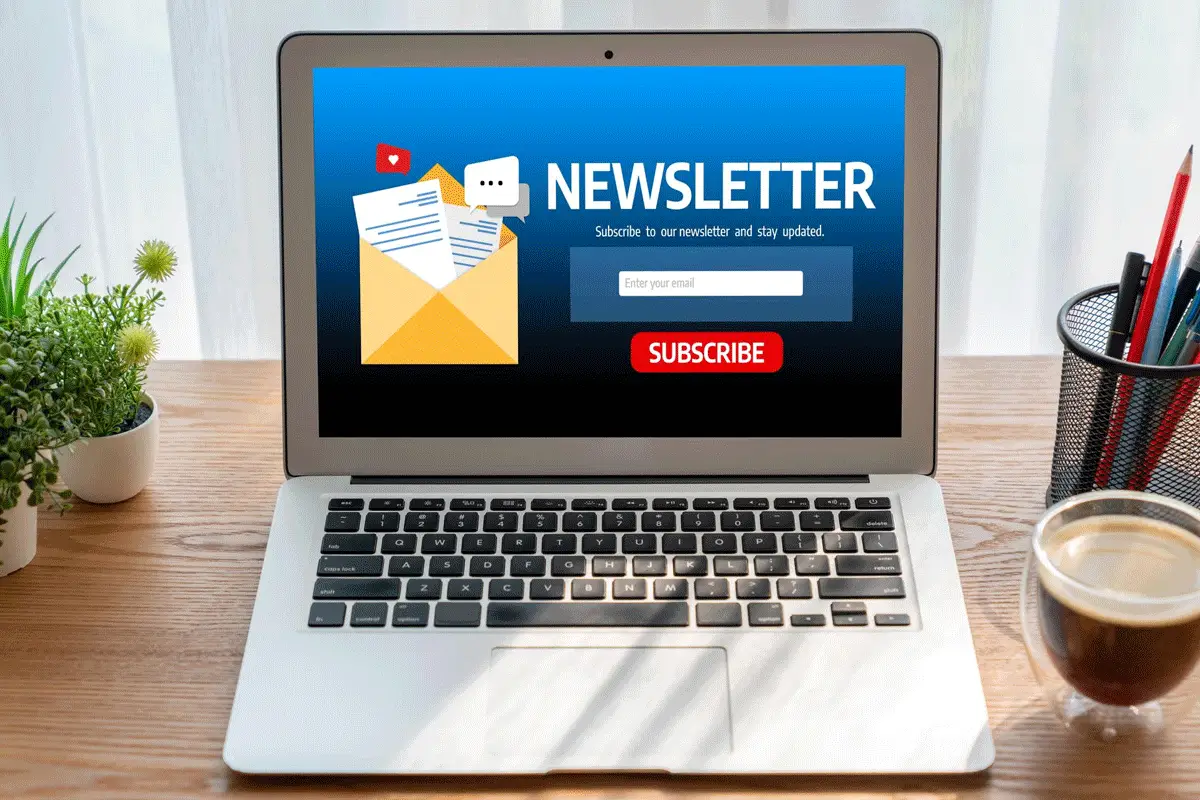Email marketing through newsletters is a powerful tool for connecting with your audience. A well-crafted email newsletter can boost engagement and drive traffic to your website, products, and services. It allows you to share valuable content, promote your items, and keep your subscribers informed about your business.
To create impactful email newsletters, this guide will explain how to focus on delivering useful information while balancing promotional content. Understanding your audience’s preferences will help you tailor your messages effectively, making them more likely to open and engage with your emails.
Understanding Email Marketing with Newsletters
Email marketing has grown into a vital part of digital marketing strategies. It allows businesses to connect directly with customers while offering high return on investment (ROI). The following sections will break down the evolution of email in marketing and what defines newsletter and email marketing.
Evolution of Email as a Marketing Channel
Email began as a simple communication tool but quickly evolved into a powerful marketing channel. Initially, companies used it to send generic messages to potential customers.
As technology advanced, marketers started to personalize emails, leading to better engagement. Today, email marketing campaigns can target specific demographics or interests. This helps increase open and click-through rates.
According to studies, email generates approximately $36 for every dollar spent. This impressive ROI highlights why many businesses prioritize email marketing. Additionally, as new regulations like GDPR emerge, the focus on compliance has shaped how marketers approach emailing strategies.
Defining Newsletter and Email Marketing
Newsletter marketing refers to sending regular emails that provide news, updates, and valuable content to subscribers. These newsletters often include promotions, tips, or educational resources tailored to your audience.
Email marketing encompasses a broader range of activities, including promotional offers and transactional emails. The main goal is engagement—encouraging subscribers to take action, such as purchasing a product or visiting your website.
Effective email marketing requires understanding your audience and their preferences. Segmenting your email list can lead to better targeting and higher engagement. Tracking metrics such as open rates and clicks is essential for improving your campaigns.
In conclusion, both newsletter and email marketing play a significant role in a successful digital marketing strategy.
Crafting Your Newsletter
Creating an effective newsletter is essential for connecting with your audience. Focus on setting clear objectives, developing engaging content, and designing an appealing layout that reflects your brand.
Setting Objectives for Your Newsletter
Before you start crafting your newsletter, define what you want to achieve. Common objectives include increasing brand awareness, driving traffic to your website, or growing engagement with your audience. Clear goals will guide your content and design decisions.
Use SMART criteria to set objectives:
- Specific: Clearly define what you want.
- Measurable: Use metrics to track success.
- Achievable: Set realistic goals given your resources.
- Relevant: Ensure goals align with overall business aims.
- Time-bound: Set deadlines for achieving your goals.
Newsletter Content Strategy
Your content should be valuable and relevant to your subscribers. Consider including a mix of the following elements:
- Company News: Share updates about your business.
- Industry Insights: Provide valuable information relevant to your audience.
- Promotions: Highlight special offers and events.
Plan your content around an editorial calendar. This helps maintain consistency and ensures timely delivery. Personalize your content to make it resonate with your readers. Use segmentation to target different groups based on their interests and behaviors.
Designing Your Newsletter
The design of your newsletter plays a crucial role in engagement. Consider the following design elements:
- Header: Include your company logo prominently.
- Fonts: Choose clear and readable fonts. Stick to one or two font styles for consistency.
- Colors: Use colors that align with your brand. Limit your palette to enhance readability.
- Images: Incorporate relevant images to make your content more engaging. Ensure they are optimized for quick loading.
Maintain a clean structure with plenty of white space. This helps prevent clutter and allows readers to focus on your content. Use a layout that is easy to follow, with a clear hierarchy of information.
Building and Managing Your Subscriber List
A strong subscriber list is essential for effective newsletter email marketing. You can enhance engagement by creating appealing sign-up forms and employing segmentation and personalization strategies to connect with your audience.
Creating Engaging Sign-up Forms
Your sign-up form is the first interaction potential subscribers have with your brand. It’s crucial to make it inviting and straightforward.
Best Practices for Sign-up Forms:
- Keep It Simple: Limit the number of fields to just the essentials. Typically, asking for an email address and a name is enough.
- Clear Call to Action: Use strong, compelling phrases like “Join Our Community” or “Get Exclusive Updates” to motivate sign-ups.
- Incentives: Offering something valuable, such as a discount or a free resource, can encourage more people to subscribe.
Position your forms prominently on your website, such as in the header, footer, or as a pop-up after a few seconds of browsing.
Segmentation and Personalization Techniques
Segmenting your email list allows you to tailor your content for different subscriber groups. This can greatly enhance engagement and retention.
Key Segmentation Strategies:
- Demographics: Categorize subscribers based on age, location, or interests to provide relevant content.
- Behavioral Data: Monitor how subscribers interact with your emails. Use this data to tailor future messages.
Personalization Techniques:
- Dynamic Content: Use the subscriber’s name in the email subject line or greeting to create a personal touch.
- Customized Recommendations: Based on past interactions, suggest products or content that align with their interests.
By focusing on these strategies, you can build more meaningful connections with your audience.
Maximizing Deliverability and Open Rates
To effectively increase your email’s deliverability and open rates, focus on key elements like your subject lines, email design, and content strategy. These factors significantly impact whether your recipients actually receive and engage with your emails.
Crafting Effective Subject Lines
Your subject line is crucial for getting recipients to open your email. Keep it concise and focused, aiming for 6-10 words. Use action verbs and make it relevant to the content inside. Personalizing the subject line can also enhance engagement; for example, including the recipient’s name can make the email feel more tailored.
Additionally, consider the timing of your emails. Sending emails at optimal times can improve open rates. Use A/B testing to experiment with different subject lines and analyze which versions resonate better with your audience. This strategy helps refine your approach over time.
Ensuring Responsive Email Design
Your email design must be mobile-friendly. A significant portion of users check their emails on mobile devices. Utilize responsive email templates that adapt to different screen sizes. Keep your layout simple with clear calls to action that stand out.
Make sure your text is legible, using a font size of at least 14px. Break up text with bullet points or short paragraphs to enhance readability. Images should be optimized and have alt text in case they don’t load. Following these design principles will help keep your audience engaged.
Dynamic Content and A/B Testing
Dynamic content helps you tailor emails based on user behavior. Personalizing emails with relevant product recommendations or location-specific messaging can significantly boost engagement rates.
Incorporate A/B testing for various elements like email design, send times, and content. This method allows you to identify which combinations yield the best results. For example, test different email templates and track which ones achieve higher open and click rates.
By continually optimizing based on data, you can enhance both your deliverability and impact, keeping your audience interested and engaged.
Measuring Success and Optimizing Performance
To improve your newsletter email marketing efforts, you need to focus on key metrics and continuously refine your approach. By utilizing analytics and A/B testing, you can enhance engagement and drive better results.
Key Metrics and Analytics
Understanding your email marketing performance starts with tracking essential metrics. Here are some of the key performance indicators (KPIs) to monitor:
- Open Rate: This shows the percentage of recipients who open your emails. A higher open rate suggests effective subject lines.
- Click-Through Rate (CTR): This measures how many users clicked on links within your email. A strong CTR indicates engaging content.
- Conversion Rate: This refers to the percentage of subscribers who complete a desired action, such as signing up or making a purchase. High conversion rates mean your emails are persuading readers effectively.
- Unsubscribe Rate: Track how many people opt out of receiving your emails. A rising unsubscribe rate can signal issues with content or frequency.
By regularly analyzing these metrics, you can gain insights into your audience’s behavior and preferences, allowing you to make informed adjustments.
Iterative Improvement with A/B Testing
A/B testing is a powerful method to optimize your email performance. By comparing two versions of an email, you can identify what resonates more with your audience.
Consider testing:
- Subject Lines: Different phrases can lead to varied open rates. Try testing clear versus creative subject lines.
- Call-to-Action (CTA): Experiment with different wording and placements for your CTAs. This can dramatically impact your conversion rates.
- Content Layout: Assess how changes in images, text placement, or color schemes affect engagement.
Using marketing automation tools can streamline this process. They can help you schedule tests and analyze results efficiently. Keep in mind that even small changes can lead to significant improvements. Regular A/B testing will not only enhance your newsletters but also maintain audience interest over time.

SEO Chatter is dedicated to teaching the fundamentals of search engine marketing to help marketers understand how to increase organic website traffic and improve search engine rankings.

